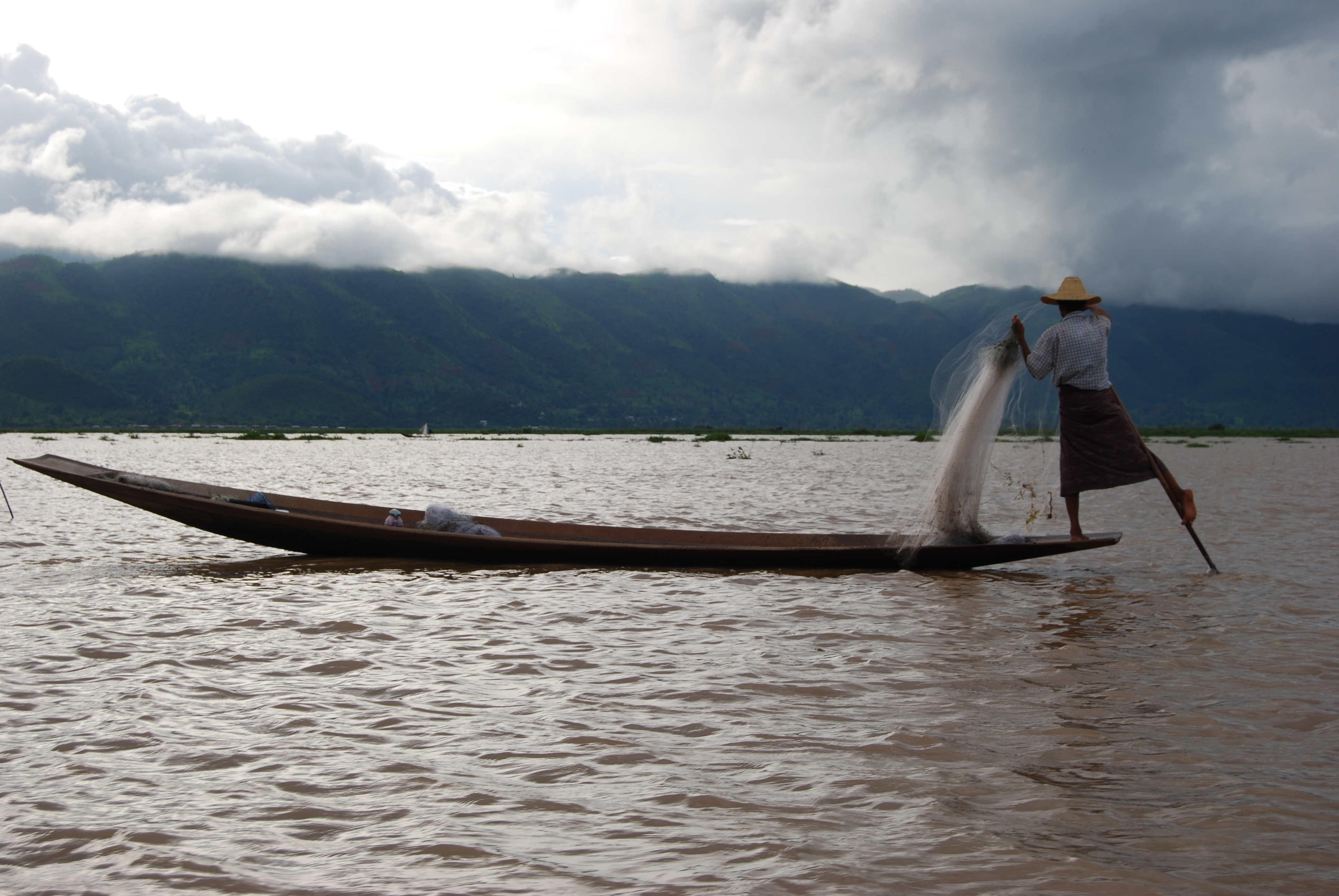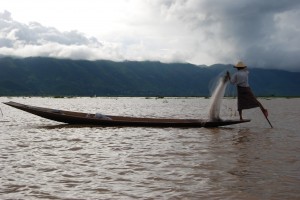Home to the one legged fishermen
August 12….You gotta love the service at Myanmar airports. I know the airports are small, very small, but the service and efficiency is amazing. Your bags are picked up at the curb, immediately tagged for your flight (there aren’t that many flights!) and disappear, to be seen again at your destination. Check in takes less than a minute – it is scramble seating on board and there’s no tedious computers, just a manifest check list, stick a little coloured sticker on the passengers’ shirt and away you go. And unbelievably, our little prop jet Air Bagan flight took off 15 minutes early, why wait when everyone is on board and ready to go?
Ok, time to come clean, we really didn’t know much about Inle Lake but our research said it was a ‘must see’. Something about a placid lake surrounded by jungle-covered mountains with floating villages and fishermen paddling boats with one leg. So it sounded good, right? Especially the bit about these poor fishermen with only one leg.
From the moment we arrived (ahead of schedule) at the local airport in Heho we fell in love with the place. On the drizzly drive to the lake we stopped at an ancient teak monastery to see young novices chant their lessons and passed through endless fields of green healthy rice at all stages of growth. We saw large groups of mainly women standing in knee deep water going through the age-old process of planting rice by hand. We were later told that often the women of the surrounding families will all work together as a group planting each other’s rice as a team so that each family can get their crop in and out on time.
From a canal connected to Inle Lake we got in our private Thai-style long boat with driver at the back and some sort of second-in-charge guy curled up in the bow. So began the journey that would sweep us away for the next two days, exploring the lives of these unique lake people, mainly from the Intha tribe. But as we were to learn, the Shan State here in eastern Myanmar has many ethnic and tribal groups in addition to the Shan. During our visit we would see Intha, Taung Yo, Danu, Kayah (better known as Karen) and our favourites, the Pa-O.
Inle Lake is probably 20 km long and 10 km wide but along its fringes it features many islands or floating islands or areas where it is kinda hard to tell where the land ends and the lake begins. And as we started to travel down the western coastline past the little thatched huts with the dramatic mountains forming a high skyline we started to see these one legged fishermen. Well, sorta.
It is an ingenious if not confounding motion to stand on one leg, paddle forward with the other leg while you are pulling, cleaning, untangling or mending your nets with your hands. And sometimes the water can be a bit bumpy, especially when tourists’ long boats go whizzing by, but the fishermen seem to manage the whole process without a blip. You can believe me when I say it made great
video.
We visited a number of small cottage industries in buildings sitting on top of stilts, including a silk and lotus weaving factory, a silversmith factory, a fascinating paper factory for making parasols and the like, a cheroot factory where they hand-roll these little cigars and a very cool monastery made of teak which featured – wait for it – jumping cats. I wasn’t leaving until I saw these jumping cats and eventually someone donated some money (presumably for some cat food) so the monk would show how he had trained these cats to jump quite high and through a large ring. You don’t get this stuff on Discovery Channel.
One feature we were absolutely amazed at was these floating gardens which are mainly located near the stilted village of Nampan. The farmers (technically not fishermen I guess) build these long trellises which they fill with plant matter and dirt. They pin them down so they don’t float away by sticking long bamboo poles through them into the bottom of the shallow lake. We were told they grow cucumbers, flowers and other things depending on the time of year but what we saw was tomatoes, rows and rows, acre after acre, smallish plants and smallish tomatoes but virtual ‘fields’ of tomatoes everywhere.
On the second day at Inle Lake we motored up a sizable tributary to the regular market at the village of Inthein. This small village is one of five villages on the lake that host the circuit of the rotating local market. It’s a special day for the villagers and tribes people from the nearby hills walk many hours down to the market in their Sunday best to trade their wares. We were told that these villagers don’t track time by days of the week, they track it by the visit of the market to their local village. So someone might say ‘I’ll meet you at Inthein in two markets’ or ‘I sold that goat three markets ago’. You get the idea.
Most of the goods traded at this market were simply laid out on a mat in the dirt, sometimes with primitive scales using old batteries as their counterweight. It was mainly fruit and vegies but also tobacco, dried fish, homemade soaps, cloth and various second hand clothing. It was made more colourful by the costumes of the various tribes people, especially the Pa-O (our favourite) whowrap very brightly coloured towels or shawls around their head. Oh yes, we took a couple of photos.
And while the women were buying and selling in their colourful and joyfully talkative manner the men were over in the corner gambling away their hard earned Kyat. There were a number of somewhat primitive gambling boards, sometimes with dice the size of a basketball with hand painted animal images on them or an odd game of throwing weirdly shaped items that would randomly fall on painted squares (maybe called Shan Roulette?) and men loudly throwing money around, betting on what would happen next. They also very forcefully told us we couldn’t take photos which led me to believe the authorities probably wouldn’t be betting on this.
Behind the village was a long covered walkway up to the top of the nearby hill where the beautiful Shwe Inn Thein Paya still stood brightly after 300 years. And around it was over 1,000 zetis, or stupas or chedis, again, take your pick. A 1,000 zetis covers a lot of ground and it was fascinating to walk amongst them in their various states of disrepair, admiring the art work and the sheer volume of the locals’ religious beliefs on display.
We walked up the mountain road and bush-bashed up another hill to get an aerial view of the temple and its forest of stupas, the village and the lake down below. Is this stuff for real?















Comments
Home to the one legged fishermen — No Comments
HTML tags allowed in your comment: <a href="" title=""> <abbr title=""> <acronym title=""> <b> <blockquote cite=""> <cite> <code> <del datetime=""> <em> <i> <q cite=""> <s> <strike> <strong>